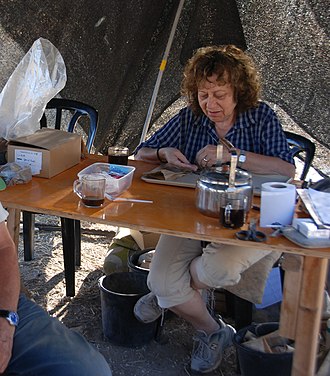Anna Belfer-Cohen

Anna Belfer-Cohen (Hebrew: אנה בלפר-כהן; born November 3, 1949) is an Israeli archaeologist and paleoanthropologist and Professor Emeritus at the Institute of Archaeology, The Hebrew University of Jerusalem. Belfer-Cohen excavated and studied many important prehistoric sites in Israel including Hayonim and Kebara Caves and open-air sites such as Nahal Ein Gev I and Nahal Neqarot. She has also worked for many years in the Republic of Georgia, where she made important contributions to the study of the Paleolithic sequence of the Caucasus following her work at the cave sites of Dzoudzuana, Kotias and Satsrublia. She is a specialist in biological Anthropology, prehistoric art, lithic technology, the Upper Paleolithic and modern humans, the Natufian-Neolithic interface and the transition to village life.[1]
Belfer-Cohen has published hundreds of papers and co-edited several books. Her work is widely cited in the field of Prehistoric Archaeology and especially the Natufian culture.[2]
Belfer-Cohen is married with two children and four grandchildren and currently resides in Jerusalem.
Anna Belfer-Cohen was born in Rivne, Ukraine in 1949 to Halina (Ala) and Yehuda Belfer. The family immigrated to Israel in 1956. After completing high school in her home town Petah Tikva, she began studying toward her first degree in archaeology at the Institute of Archaeology, The Hebrew University of Jerusalem, where she also earned her MA (1981) and PhD (1988). Already in her undergraduate studies she participated in many archaeological expeditions in Israel, Cyprus and Sinai.[3] Belfer-Cohen’s PhD dissertation (supervised by Professor Ofer Bar-Yosef) was dedicated to the Natufian culture.[4] She was appointed full professor at the Institute of Archaeology, The Hebrew University of Jerusalem, in 2002. From 2005–2009, she served as the head of the university’s Institute of Archaeology. From 2014 to 2018 she was the head of the Authority for Research Students (non-experimental Sciences).
Early in her career, Belfer-Cohen participated in excavations at the Lower Paleolithic site of ‘Ubeiydia in the Jordan Valley (the oldest site in Israel), at Upper Paleolithic and Epipaleolithic prehistoric sites in the northern Sinai Desert, at the burial sites from the Chalcolithic age and Early Bronze Age in the southern Sinai.
During her MA studies, Belfer-Cohen analyzed the lithics and bone tools from the Aurignacian layer at Hayonim cave (dated to 35,000 years ago). In her work she identified the Levantine Aurignacian and its uniqueness in the Upper Paleolithic sequence in the area. Through the years she helped understanding the interactions of this hunter-gatherer culture with its European counterpart.[5]
In her PhD Belfer-Cohen discussed the technological and spatial aspects of the Natufian material remains from Hayonim Cave in the Galilee, including architecture, burials, lithic assemblages, ground-stone tools and personal ornaments.[6] In this work she provided the basis for the modern study of the Natufian culture and shaped the important research questions, which are still employed by the current research.
